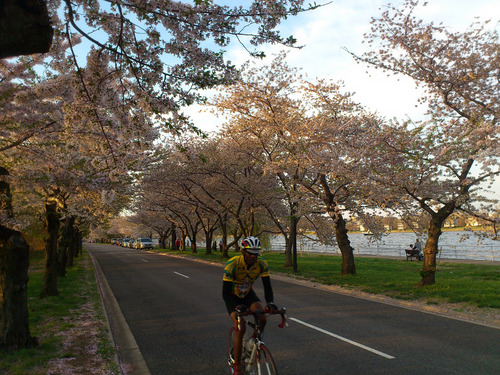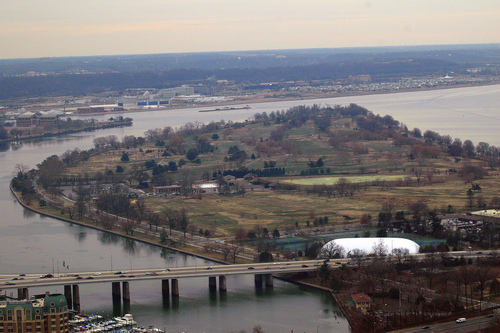Thanks to World War II, we love to bike here
Hains Point, which sits at the southern end of DC’s East Potomac Park, has long been one of the District’s prime destinations for serene river views — especially for cyclists who want a flat, lightly-trafficked, gently curving course for serious exercise. Yet even though it was built in 1917, it only became a popular place to bike after World War II (and car rationing) started.
Take Ohio Drive well past the tidal basin and the Thomas Jefferson Memorial and you’ll hit East Potomac Park, with groves of cherry trees lining the fringes of its 36-hole golf course, and eventually Hains Point, where a group of picnic tables command a view far down the Potomac River. The roads that encircle the island are popular with DC-area road cyclists, who gather in groups to ride in clockwise laps.
What many might not know is that its track-like drive first gained popularity as a cycling destination during the “Rosie the Riveter” days of World War Two, when the Park Service sought to encourage cycling instead of driving as a way to see the park.
According to the National Park Service’s Historic American Buildings Survey description of East Potomac Park:
The most popular means of access by far, however, was by automobile. As the number of automobiles in the District increased, the park attracted more and more visitors seeking the cool breezes at Hains Point in the midst of Washington’s hot summers. To accommodate the increasing number of motorists, the OPB&G built a shelter with restrooms at the southern tip of the park in 1922.
When the United States entered World War II, NPS closed the tea house at Hains Point since its use as a recreational automotive destination was inconsistent with the national effort to conserve tires and gas… A bicycle-rental facility in the park thrived on the business from the new crowd of wartime workers.
Regional population had increased with the war and subsequently, traffic congestion worsened. The stables closed in 1950 when the mixture of automobiles and equestrians were seen as a safety hazard. Likewise the demand for bicycles decreased and the rental shop closed in 1955.
Although the bike rental shop might be long-gone, East Potomac Park does have a Capital Bikeshare station.
Meanwhile, another historic way of getting to Hains Point is about to make a comeback.
For a brief period between 1919 and 1921, the park was accessible not only by automobile, but also by ferry. A boat called the Bartholdi ferried passengers between the government wharf in Southwest and the tip of West Potomac Park, named Hains Point in 1917.
The Wharf’s developers promise that they will re-launch a ferry across the Washington Channel after the development opens next year, docking at a newly built pier behind the fish market. The bike shop that’s proposed nearby could prove convenient for flat-tire-stricken cyclists, and visitors to the park’s golf course, mini-golf course, tennis courts, swimming pool, picnic areas, and cherry groves could enjoy different dining options besides the golf course’s snack bar.


